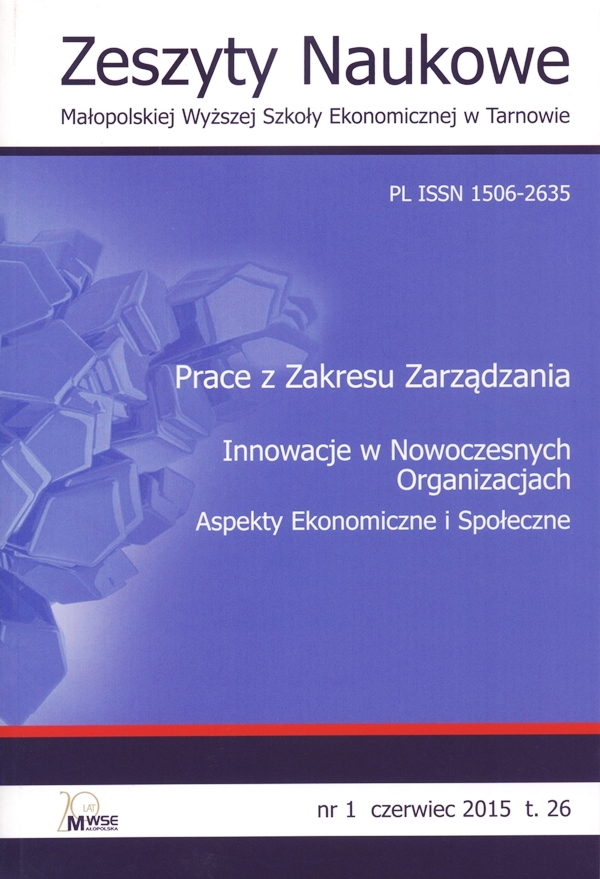Abstract
Nowadays, innovation is an important factor for socio-economic development. In the era of globalization, increased customer expectations as well as increasing competition of companies are forced to take continuous innovation activities. Such firms would like to remain on the market and they are aimed at the development. The research conducted both at the enterprise and national or international level, shows a significant impact of innovation activities undertaken the condition of individual operators, as well as the entire economies. Innovative activities, implemented by companies, bring them a number of benefits. That is, among others, introduction of new products and services to the market, the use of new production technology or in the long term, costs reduction, market extension, keeping up with ever more exorbitant consumers requirements. Hence, it is important that in each country there are adequate mechanisms encouraging businesses to increase funds on research and development activities. Therefore, as the purpose of the article, the author has adopted an attempt to discern the level of innovative activity undertaken by Polish companies. In the first part of the article, on the basis of literature, the theoretical foundations of innovation have been presented, showing the diversity of the term definitions as well as indicating the types of innovation. In the second part of the article the author used the secondary data from the Central Statistical Office, Eurostat and data contained in the reports on the issues of innovation in order to present the level of innovative activities undertaken by Polish companies.
References
Eurostat Statistics Database (2013) [online, dostęp: 2013-12-12]. Dostępny w Internecie: http://epp.eurostat.ec.europa.eu/portal/page/portal/science_technology_innovation/introduction.php/Innovation_statistics.
Global Innovation Barometer (2013) [online, dostęp: 2014-02-27]. Dostępny w Internecie: http://files.publicaffairs.geblogs.com/files/2013/01/Poland.
GUS (2011). Działalność innowacyjna przedsiębiorstw w latach 2006–2009. Informacje i Opracowania Statystyczne. Warszawa: Główny Urząd Statystyczny – Urząd Statystyczny w Szczecinie.
GUS (2012). Działalność innowacyjna przedsiębiorstw w latach 2009–2011. Informacje i Opracowania Statystyczne. Warszawa: Główny Urząd Statystyczny – Urząd Statystyczny w Szczecinie.
GUS (2012a). Społeczeństwo informacyjne w Polsce. Wyniki badań statystycznych z lat 2008–2012. Informacje i Opracowania Statystyczne. Warszawa: Główny Urząd Statystyczny – Urząd Statystyczny w Szczecinie. ISSN 1898-7583.
Janasz, W., Kozioł, K. (2007). Determinanty działalności innowacyjnej przedsiębiorstw. Warszawa: PWE. ISBN 83-208-1658-0.
Kotler, Ph. (1994). Marketing. Analiza, planowanie, wdrażanie i kontrola. Warszawa: Gebethner i S-ka. ISBN 83-85205-42-X.
Matusiak, K.B. (red.) (2011). Innowacje i transfer technologii – słownik pojęć. Warszawa: Polska Agencja Rozwoju Przedsiębiorczości. ISBN 978-83-7633-164-5.
OECD (2008). Podręcznik Oslo. Pomiar działalności naukowej i technicznej: zasady gromadzenia i interpretacji danych dotyczących innowacji. Wspólna publikacja OECD i Eurostatu. Wyd. 3. Warszawa: Ministerstwo Nauki i Szkolnictwa Wyższego. Departament Strategii i Rozwoju Nauki. ISBN 978-83-61100-13-3.
Porter, M.E. (1990). The Competitive Advantage of Nations. London: Macmillan.
Schumpeter, J.A. (1960). Teoria rozwoju gospodarczego. Warszawa: PWN.
Wiankowski, S. et al. (2005). Dostosowanie sfery badawczo-rozwojowej w Polsce do funkcjonowania w Europejskiej Przestrzeni Badawczej. Warszawa: Instytut Organizacji i Zarządzania w Przemyśle „Orgmasz”. ISBN 83-86929-92-8.
Zembaczyński, R. et al. (1997). Instrumenty transferu technologii i pobudzania innowacji: raport uzupełniający. Warszawa: Zespół Zadaniowy ds. Polityki Strukturalnej w Polsce.
© Copyright by Małopolska School of Economics in Tarnów. The articles are available under the Creative Commons Attribution NonCommercial-NoDerivatives 4.0 International License


